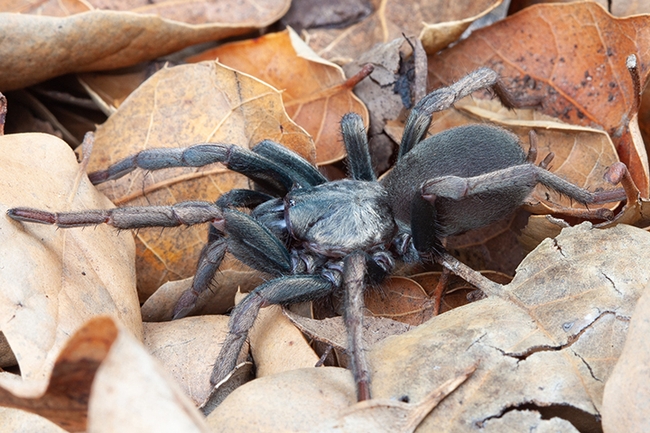
What, you don't? They scare you? And you scream?
Fear not.
Arachnologists will set the record straight. (Maybe not your scream, though!)
Just in time for Halloween, the next UC Davis Department of Entomology and Nematology seminar will be on spiders.
Arachnologist Rodrigo Monjaraz-Ruedas of San Diego State University's Department of Biology, will speak on "Ring Species, Ring Speciation or a Ring of Species? An Example with California Mygalomorph Spiders" at 4:10 p.m., Monday, Oct. 30 in Room 122 of Briggs Hall. It also will be on Zoom.
The Zoom link:
https://ucdavis.zoom.us/j/95882849672
"Ring species can be defined as a chain of interbreeding populations which expands along two pathways around a geographic barrier, where terminal forms can coexist without interbreeding," Monjaraz-Ruedas writes in his abstract. "A broken ring species model preserves the geographic setting and fundamental features of an idealized model but accommodates varying degrees of gene flow restriction through evolutionary time. Members of the genus Calisoga are distributed around the Central Valley of California, and previous genetic studies have shown that this is a lineage-rich complex of mygalomorph spiders, with evidence to suggest that Calisoga might be a case of ring speciation. Here we examine broken ring species dynamics in Calisoga spiders, using UCEs and mitogenomes we test key predictions of timing, ancestry, connectivity and terminal overlap. I will discuss why ring species should not be viewed as homogeneous entities, but rather as heterogeneous units with different predicted evolutionary dynamics in different geographic parts of the ring."
Monjaraz-Ruedas joined the Marshal Hedin lab at San Diego State University as a postdoctoral research fellow in 2020. He studies "Phylogenomic, spatial phylogenetics and conservation prioritization in trapdoor spiders (and kin) of the California Floristic Province."
The Hedin lab focuses on arachnids, with particular emphasis on mygalomorph spiders and Opiliones (harvesters)," according to its website. "Species discovery, delimitation and description is important to us--although the biological world is amazingly diverse, most biodiversity remains undiscovered and undescribed. We spend a considerable amount of time conducting fieldwork--the western US and Appalachian mountains are hotspots for our research efforts. Cave arachnids interest us! In the lab we strive to be integrative, but our strength lies in molecular phylogeography and phylogenomics."
Monjaraz-Ruedas' most recent publications include:
- Cruz-López, J. A., Monjaraz-Ruedas, R. Colmenares, P. A. & Francke, O. F. 2021. Historical
biogeography of a neglected family of armoured harvestmen (Opiliones: Laniatores: Icaleptidae) with the first record and a new genus for tropical Mesoamerica. Invertebrate Systematics. 35: 493– 513. - Francke, O. F., Monjaraz-Ruedas, R., Cruz-López, J. A. 2021. Biodiversity of Huautla Cave System, Oaxaca, Mexico. Diversity. 13: 429.
- Monjaraz-Ruedas, R.,. Francke, O. F. & Prendini, L. 2022. World Travelers: parthenogenesis and ecological tolerance enable multiple colonization events by the widespread short-tailed whipscorpion, Stenochrus portoricensis (Schizomida: Hubbardiidae). Insect Systematics and Diversity. 6(1): 7, 1–17.
- Monjaraz-Ruedas, R., Mendez, R.W., Hedin, M. (2023). Species delimitation, biogeography, and natural history of dwarf funnel web spiders (Mygalomorphae, Hexurellidae, Hexurella) from the United States / Mexico borderlands. Zookeys. 1167: 109–157.
- Monjaraz-Ruedas, R., Starret, J., Dean Leavitt, D., Hedin, M. (In Review). Ring species dynamics in California mygalomorph spiders (Nemesiidae, Calisoga). The American Naturalist.
Monjaraz-Ruedas holds three degrees from the Universidad Nacional Autónoma de México (UNAM): a bachelor's degree in taxonomy; a master's degree in morphological systematics; and a doctorate in molecular phylogenetics. His doctoral dissertation: “Systematics of the genus Stenochrus Chamberlin, 1922 (Schizomida: Hubbardiidae).”
He has guest-lectured on arachnids at San Diego State University, and was a member of the UNAM science faculty, serving as a lecturer in systematic biology from 2019 to 2020. He also worked as an assistant collection manager of the arachnids collection, UNAM Biology Institute, from 2010-2013.
Seminar coordinator is Brian Johnson, associate professor, UC Davis Department of Entomology and Nematology. For Zoom technical issues, he may be reached at brnjohnson@ucdavis.edu. The list of seminars is posted here.
Attached Images:
